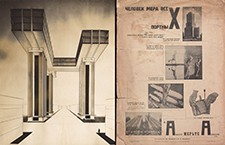Hosted by Kasiet Toktomusheva
Variously described as a "sky stirrup," a "cloud iron," or a "cloud presser," the Wolkenbügel was El Lissitzky's most provocative contribution to architectural culture in the 1920s. Lissitzky conceived the Wolkenbügel during a period of intense productivity while undergoing treatment for tuberculosis in 1924-25 in Switzerland. First exhibited in Mannheim and Berlin, the project was described most fully in the pages of Izvestiia ASNOVA [ASNOVA News], which Lissitzky designed and edited for the Moscow-based Association of New Architects in 1926. The project emerged from, and was informed by, Lissitzky’s network of relationships that spanned Europe and the Soviet Union. As scholars have noted, the Wolkenbügel registered Lissitzky's deep engagement with "Americanism" and the emergence of new technologies and building types. Likewise, the Wolkenbügel clearly drew on Lissitzky's earlier painterly practice, evoking the forms that feature in his “PROUN” paintings. This paper addresses Lissitzky's project by synthesizing his preoccupations with scale, movement, and the conditions of visuality in the modern city. A key to understanding the Wolkenbügel is the enigmatic "Feuilleton of images" that Lissitzky published on the final page of Izvestiia ASNOVA. Using bold phrases such as "measure architecture by architecture" and "learn to see what is in front of your eyes," this typo-photo composition presented the incommensurability of human and architectural scales, suggesting that a new art of seeing was required to understand and inhabit the contemporary city. Attending to Lissitzky's concerns with visuality, orientation, and dynamism, this analysis asks how the Wolkenbügel manifested his interest in activated spectatorship and explores how the project served as a complement to his contemporaneous designs for demonstration spaces (Demonstrationsräume).

